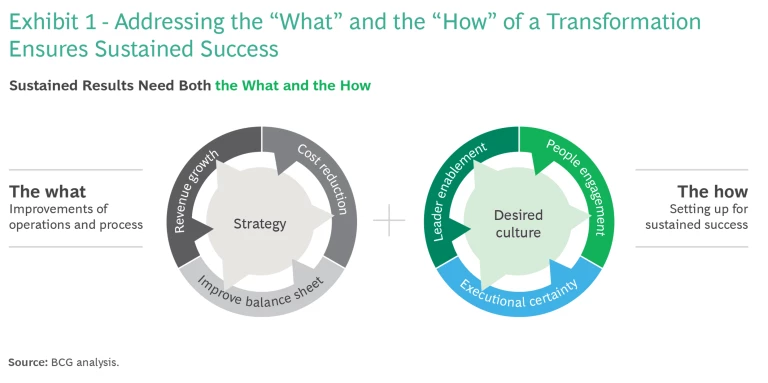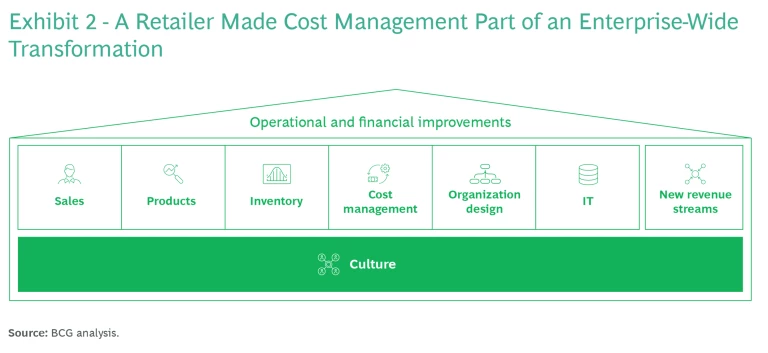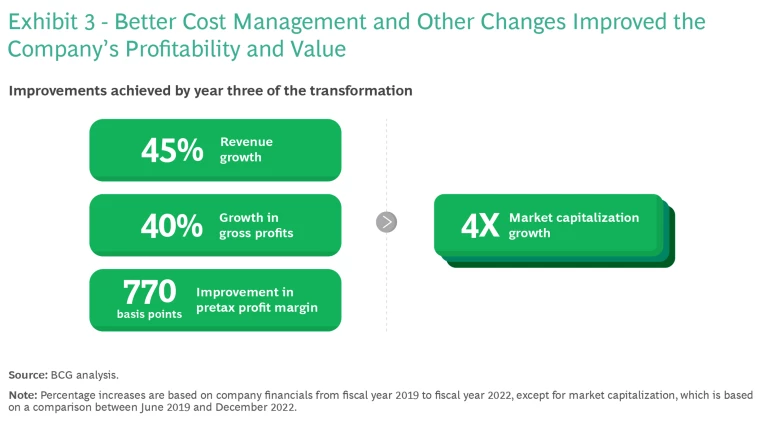Organizations worldwide are contending with shifting markets, supply chains, and customer dynamics, as well as the push for continuous improvement. When they launch a business transformation to respond, improving cost management is invariably part of the process.
At a minimum, better cost management means improving cost controls. It can also manifest as an enterprise-wide drive for more strategic spending in order to unlock resources for new operating models and for targeted efforts to support profitability and a superior customer experience.
Companies often take out costs by slashing budgets and reducing headcount. But the results of such extreme measures generally don’t justify the means. Sudden, drastic cuts that involve major workforce reductions can hurt productivity and leave employees feeling stressed and disengaged. And even a strong start to a cost program—regardless of the cuts made—won’t guarantee lasting change. A recent BCG survey of 600 CEOs found that although 80% said they had met cost targets, close to 30% reported costs creeping back in.
By contrast, a holistic, outcome-based cost management approach that’s part of an enterprise-wide transformation can change an organization’s business for the long term and allow it to operate at its full potential. It uses quick wins to release capital to fund long-term strategic initiatives. And it allows the organization to deliver offerings that are well-suited to its customer base and produce favorable financial results.
To succeed with such an approach, corporate leaders must have a clear vision of the business that allows them to understand what needs to change, and they must align the cost transformation to the company’s purpose and get middle managers onboard. Companies also should use incentives to steer performance and take quick wins to boost morale.
Making Transformations Effective
We know from previous BCG research that only a quarter of transformations are successful. The vast majority fail to deliver in the long term because companies do not fundamentally change. A holistic approach to managing costs can increase a transformation’s chance of success by contributing to three critical outcomes:
- Sustained value creation, with a focus on continuous value delivery and gains maintained after the transformation
- A step change in capabilities so that the organization is fully equipped to drive continuous improvement
- A sustained shift in the culture, ensuring that the organization is aligned and engaged in new ways of working
Companies with transformations that generate all three outcomes are three times more likely to have short- and long-term total shareholder returns that outperform the average for their sector. Of the transformations we’ve worked on in the past five years, the 50 largest delivered 15% higher TSR compared with relevant stock indices.
Part of what made these high achievers successful was a dual focus on both the “what” and the “how” of their transformation—on what the change would deliver and how it would accomplish the change. Focusing on both ensures short-, medium-, and long-term success. (See Exhibit 1.)

How One Retailer Implemented a Holistic Cost Management Approach
Over the past five years, we’ve successfully employed a holistic approach in more than 500 retail cost management projects. One involved a major specialty retailer in a developing economy. For years, the company had followed the mantra of growth at all costs. The decision to maximize revenue to gain market share had turned the business into a market leader. But that singular focus caused other aspects of the business to suffer.
Limited insight into the cost of goods sold, suboptimal evolution of the inventory mix, and failure to meet changing customer demands were causing margins to shrink. In addition, the lack of a disciplined approach to monitoring operating and financing costs was constraining the company’s profitability. These troubles had led to continued operating losses and year after year of negative results.
The company implemented a multiphase, multiyear transformation to revise its strategy and correct operational issues, with the goal of reversing negative results, improving profits, and creating value. The transformation—which involved revamping sales, product mix, inventory, and organization design, as well as launching new revenue streams—touched every aspect of the business. (See Exhibit 2.) Getting a better grip on costs was an essential part, as the company needed the resources released by eliminating unnecessary costs to fund its growth plan.

What Changes Were Made
The cost program’s main goal was imbuing new discipline and efficiency into the company’s entire cost base. This was accomplished through several measures.
Renegotiating Merchandise Terms. The company launched “fact-based negotiations” with all key suppliers to improve the cost of goods sold while ensuring that terms were still favorable for both parties. The negotiations were predicated on a detailed view of gross and net profitability at the SKU level and on a comprehensive analysis of the differences between projected and realized sales for each supplier and the key drivers of any shortfalls. The renegotiated contracts led to a 1.6% improvement in gross margin.
Reworking the Operating Cost Base. Companies typically launch a cost initiative by addressing their biggest cost centers first, since those represent the biggest potential for improving efficiencies. After analyzing operating cost items, the retailer launched the following three initiatives to make spending more effective, which together helped reduce the ratio of operating expenses to sales by 3.3 percentage points in a year:
- Renegotiated retail store leases. The company reworked rental agreements for all its retail locations, reducing those costs by 25%.
- Reassessed staffing levels and personnel costs. A workforce analysis revealed that the company’s retail stores were understaffed. The analysis identified the types and number of positions to add, and the subsequent 15% increase in in-store personnel resulted in revenue that was 24 times higher than the costs associated with hiring.
- Instituted solid cost discipline. The company set up a rapid, agile process to monitor spending across all cost categories, which minimized unnecessary spending. More rigorous discipline helped allocate spending throughout the year to yield the highest return on sales.
Establishing a Cash Office. Creating a cash office function to manage payments and cash flow strategies allowed the company to benefit from a better cash balance.
How the Changes Were Implemented
Leaders at the retailer created new processes to put the changes into effect:
- They assigned clear responsibilities for each initiative.
- They set up a central cost team within the larger transformation office to closely monitor costs and spending. The team worked in an agile manner, meeting every day, week, or month, depending on the nature of the cost changes being implemented.
- They designed and launched pilot projects for each change as a proof of concept before rolling them out at scale.
The company implemented the cost-related changes and the entire transformation in phases. It kicked off the cost program with a series of quick, easy fixes, while simultaneously designing a first wave of more substantial changes to the cost structure. Once the first phase was implemented, leaders began planning the second phase of projects. They established a workflow—which was repeated in the rollout of all subsequent change initiatives—that didn’t overtax the capacity of the teams doing the work.
Resources unlocked through these cost management measures helped provide funding for the overall transformation program, as well as for new ventures, one of which was an online marketplace. The marketplace allowed the company to partner with a number of high-level merchants and significantly expand its e-commerce presence. It was an immediate success, accounting for 38% of the retailer’s total e-commerce business only six months after it was launched.

The retailer's cost initiative, as well as other components of the transformation, helped shift the company’s focus from revenue to profitability. (See Exhibit 3.) It adopted a more data-driven, systematic approach to resolving challenges and used incentives to motivate departments and improve collaboration among them.
All told, the transformation rehabilitated the company’s financial performance, turning it into a business that produced sustainable profits and quadrupling its market capitalization in three years.
Considerations in Implementing a Cost Transformation
Corporate leaders who want to duplicate our retail client’s success should keep the following considerations in mind when launching cost programs to support a business transformation.
Start with a clear vision. Assess existing costs and their ROI or relevance to the business. The goal is to identify unnecessary spending that a cost campaign can target. Having a specific vision and an understanding of how cost transformation savings will be used provides direction and helps explain the need for action to the people who will be doing the work.
Align cost management with the company’s purpose. Purpose is the driving force behind an organization’s existence. When cost management initiatives are connected to purpose, they are more likely to be successful and sustainable. Leaders can use purpose proactively, to shape and share their vision for cost-related changes, reassure customers, manage volatility, and gain market share. They can use purpose defensively, too, to reassure workers whose anxiety regarding the cost transformation may lead them to be less motivated or productive.
Get middle managers onboard. Motivating midlevel managers is a game changer. Leaders at this level run the day-to-day activities of a cost program, so getting their buy-in from the beginning is a must. If managers are motivated, they will be more amenable to putting in the work and convincing others to do the same. They will also be more likely to produce additional ideas for cost savings.
Use incentives to steer performance. Offer incentives to managers and employees at all levels to encourage them to reach the program’s goals, but make sure rewards line up with transformation targets. Before our retail client’s transformation, the company had structured incentives to boost sales rather than profits, and departments were using their own key performance indicators. The result was a disjointed culture that discouraged collaboration.
Take quick wins. Kicking off a cost transformation with a few easy victories doesn’t just release savings to reinvest in new initiatives. It’s also a great morale booster. For an organization that has been struggling, early results of a well-managed cost transformation can improve engagement, encouraging people with the needed skills to stay with the organization and making it easier to attract new hires. At the beginning of our engagement with the retail client, we kept track of the changes the company made to routine tasks as a way to show the collective impact of even small wins. Sharing minor victories helped employees realize the influence they could have, which motivated them to trust the process and contribute to it.
Improving cost management can be an integral part of an enterprise-wide transformation. Successful cost campaigns take a holistic approach to transform the business efficiently and effectively for the long term. And they focus equally on what needs to change and how the changes will be carried out.






